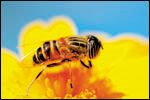Analyzing Honey Bee Immunity With Nano LC–MS
A new study published in the Journal of Chromatography A presents a sensitive method for the quantification of apidaecins, a type of antimicrobial peptide that play an important role the immune response of honey bees to pathogens. The method was developed using reversed-phase nanoliquid chromatography coupled with high resolution mass spectrometry (LC–MS) to determine apidaecins in hemolymph or body parts from individual honey bees.
Page 7

(Photo Credit: Getty Images) A new study published in the Journal of Chromatography A presents a sensitive method for the quantification of apidaecins, a type of antimicrobial peptide that play an important role the immune response of honey bees to pathogens.1 The method was developed using reversed-phase nanoliquid chromatography coupled with high resolution mass spectrometry (LC–MS) to determine apidaecins in hemolymph or body parts from individual honey bees.
There are three defence mechanisms that make up the immunity of honey bees: physical, cellular, and humoral. Antimicrobial peptides make up a key part of honey bee humoral immunity but, according to lead author Jiri Danihilik, the majority of published research is focused on the quantitation and analysis of gene expression. Danihilik told The Column: “Some groups have reported quantitative studies also on the peptide level determined in bee haemolymph by HPLC methods using UV detection, but the limited sensitivity of this methodology required sampling of hundreds of bee individuals.”
The study authors set out with the objective of developing an analytical method to quantify bee antimicrobial peptides in individual bees or their body parts. Danihilik told The Column: “We started with the smallest one, apidaecin, which [was] revealed to be quite challenging due to its very high basicity complicating sample preparation, storage, and chromatographic analysis.”
Honey bees were collected in the summer of 2012 in the Czech Republic from a private apiary. Samples were dissected and extracted and then analyzed by nanocapillary LC–MS. Danihilik told The Column: “We use a homogenate from freshly emerged bees to protect losses of the synthetic standard during calibration. Without this, you would see your precious peptide adsorbed to whatever surfaces it encounters on its way from the homogenization tube to LC–MS detector.”
The method was successfully performed to analyze apidaecin 1 isoforms in hemolymph, thoraxes, and heads. The authors state that the method is a proof-of-concept for the analysis of basic antimicrobial peptides in other organisms. Danihilik said: “Antimicrobial peptides are a hot topic in science and medicine in relation to emerging bacterial resistance to classical antibiotics, and this kind of quantification method can be very useful for further research in this area. Concerning the bees, our approach enables to quantify apidaecin peptide in single bees. In this way we can confirm that active peptides are present in small amounts even in ‘clinically healthy’ bees which were not previously challenged by pathogen infection.” - B.D.
Reference
1. J. Danihilik et al., Journal of Chromatography A 1374, 134–144 (2014).
This article is from The Column. The full issue can be found here>>

Altering Capillary Gas Chromatography Systems Using Silicon Pneumatic Microvalves
May 5th 2025Many multi-column gas chromatography systems use two-position multi-port switching valves, which can suffer from delays in valve switching. Shimadzu researchers aimed to create a new sampling and switching module for these systems.
Studying Cyclodextrins with UHPLC-MS/MS
May 5th 2025Saba Aslani from the University of Texas at Arlington spoke to LCGC International about a collaborative project with Northwestern University, the University of Hong Kong, and BioTools, Inc., investigating mirror-image cyclodextrins using ultra-high performance liquid chromatography–tandem mass spectrometry (UHPLC–MS/MS) and vibrational circular dichroism (VCD).

.png&w=3840&q=75)

.png&w=3840&q=75)



.png&w=3840&q=75)



.png&w=3840&q=75)









